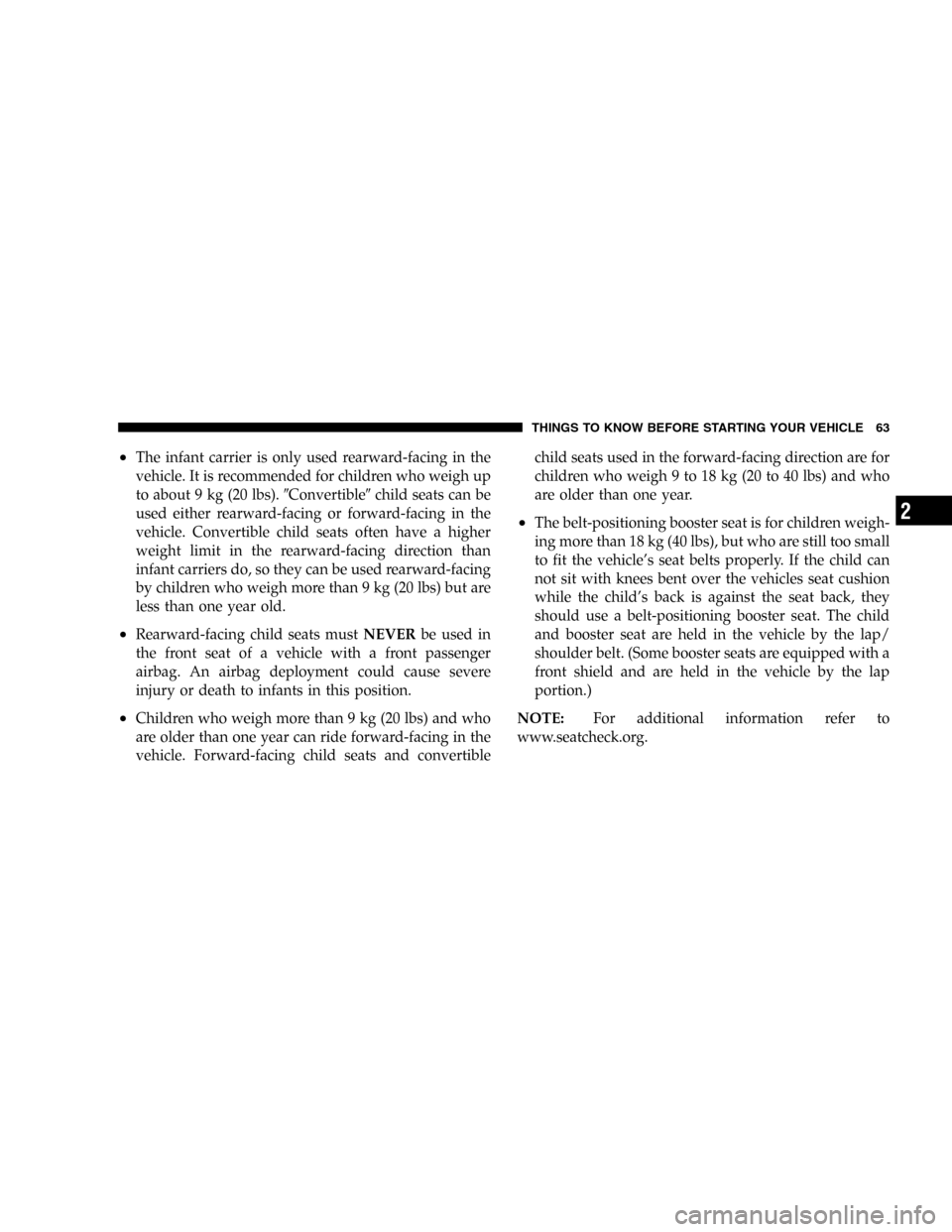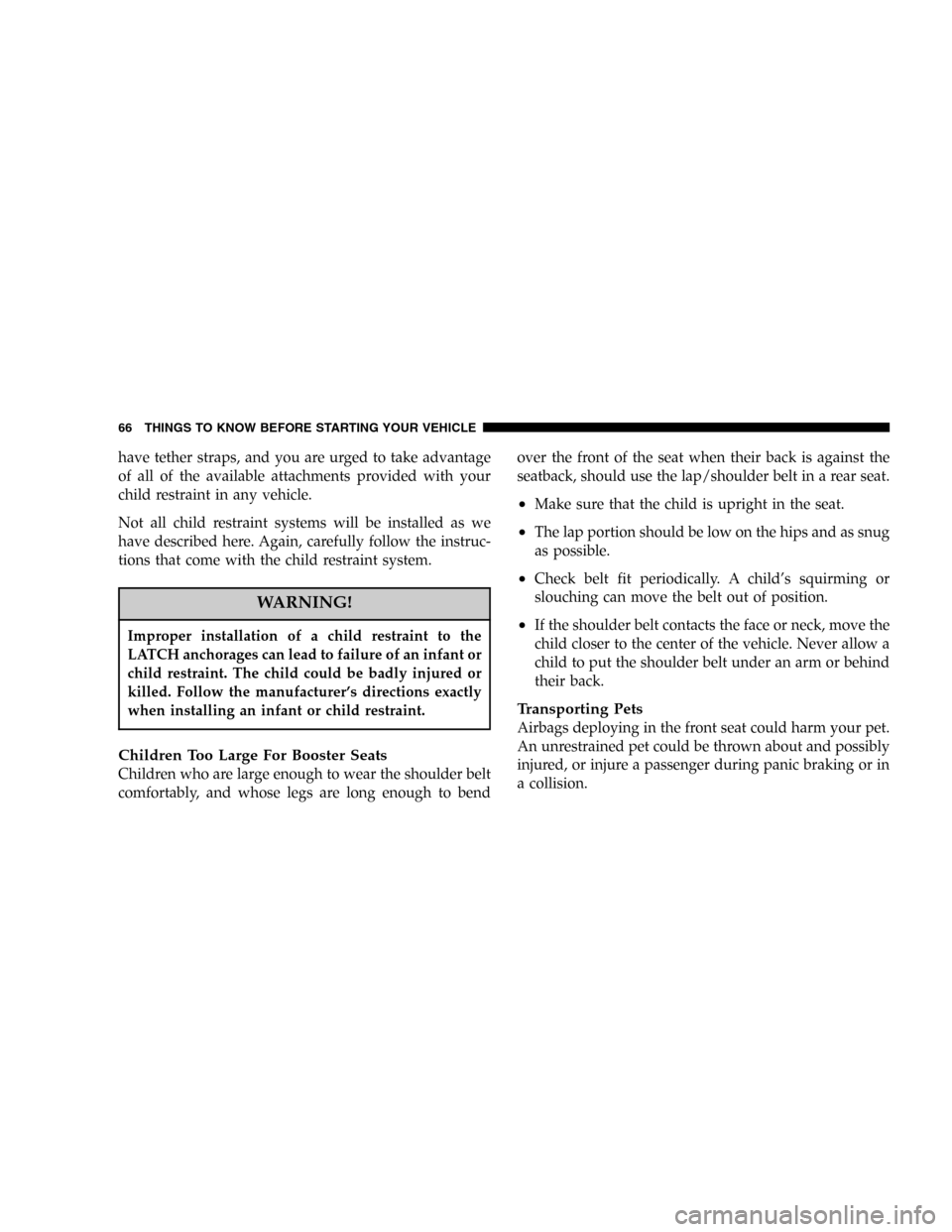Page 63 of 420

•The infant carrier is only used rearward-facing in the
vehicle. It is recommended for children who weigh up
to about 9 kg (20 lbs).�Convertible�child seats can be
used either rearward-facing or forward-facing in the
vehicle. Convertible child seats often have a higher
weight limit in the rearward-facing direction than
infant carriers do, so they can be used rearward-facing
by children who weigh more than 9 kg (20 lbs) but are
less than one year old.
•Rearward-facing child seats mustNEVERbe used in
the front seat of a vehicle with a front passenger
airbag. An airbag deployment could cause severe
injury or death to infants in this position.
•Children who weigh more than 9 kg (20 lbs) and who
are older than one year can ride forward-facing in the
vehicle. Forward-facing child seats and convertiblechild seats used in the forward-facing direction are for
children who weigh 9 to 18 kg (20 to 40 lbs) and who
are older than one year.
•The belt-positioning booster seat is for children weigh-
ing more than 18 kg (40 lbs), but who are still too small
to fit the vehicle’s seat belts properly. If the child can
not sit with knees bent over the vehicles seat cushion
while the child’s back is against the seat back, they
should use a belt-positioning booster seat. The child
and booster seat are held in the vehicle by the lap/
shoulder belt. (Some booster seats are equipped with a
front shield and are held in the vehicle by the lap
portion.)
NOTE:For additional information refer to
www.seatcheck.org.
THINGS TO KNOW BEFORE STARTING YOUR VEHICLE 63
2
Page 66 of 420

have tether straps, and you are urged to take advantage
of all of the available attachments provided with your
child restraint in any vehicle.
Not all child restraint systems will be installed as we
have described here. Again, carefully follow the instruc-
tions that come with the child restraint system.
WARNING!
Improper installation of a child restraint to the
LATCH anchorages can lead to failure of an infant or
child restraint. The child could be badly injured or
killed. Follow the manufacturer’s directions exactly
when installing an infant or child restraint.
Children Too Large For Booster Seats
Children who are large enough to wear the shoulder belt
comfortably, and whose legs are long enough to bendover the front of the seat when their back is against the
seatback, should use the lap/shoulder belt in a rear seat.
•Make sure that the child is upright in the seat.
•The lap portion should be low on the hips and as snug
as possible.
•Check belt fit periodically. A child’s squirming or
slouching can move the belt out of position.
•If the shoulder belt contacts the face or neck, move the
child closer to the center of the vehicle. Never allow a
child to put the shoulder belt under an arm or behind
their back.
Transporting Pets
Airbags deploying in the front seat could harm your pet.
An unrestrained pet could be thrown about and possibly
injured, or injure a passenger during panic braking or in
a collision.
66 THINGS TO KNOW BEFORE STARTING YOUR VEHICLE
Page 72 of 420

�Seats................................102
▫10–Way Driver’s Power Seat—If Equipped . . 102
▫8–Way Driver’s Power Seat—If Equipped . . . 103
▫4–Way Passenger’s Power Seat............103
▫Adjustable Head Restraints..............104
▫Heated Seats—If Equipped.............105
▫Second Row Manual Seat Recliner
—If Equipped.......................107
▫Second Row Manual Seat Adjuster
—If Equipped.......................108
▫Second Row Bench Seating—If Equipped . . . 109
▫Second Row Fold & Tumble Seats
—If Equipped.......................110
▫Third Row Easy Exit—If Equipped........111▫Third Row Seating—If Equipped.........113
▫Load Floor—If Equipped...............114
▫Plastic Grocery Bag Retainer.............115
�Driver Memory System—If Equipped.......116
�To Open And Close The Hood.............119
�Lights...............................120
▫Overhead Console Map/Reading Lights.....120
▫Interior Lights.......................121
▫Multi-Function Lever...................122
▫Headlights, Parking Lights, Instrument Panel
Lights.............................122
▫Automatic Headlights..................123
▫Daytime Running Lights (Canada Only).....124
72 UNDERSTANDING THE FEATURES OF YOUR VEHICLE
Page 102 of 420
SEATS
10–Way Driver’s Power Seat—If Equipped
The driver’s power seat switches are located on the
driver’s front door trim panel. The bottom switch con-
trols up/down, forward/rearward, and tilt adjustment.
The top switch controls the seatback recline adjustment
and the middle switch controls the lumbar adjustment.
10–Way Driver’s Power Seat
102 UNDERSTANDING THE FEATURES OF YOUR VEHICLE
Page 105 of 420
Heated Seats—If Equipped
This feature heats the driver, front passenger and second
row seats. The controls for the front heated seats are
located on the door trim panel next to the power seat
switches.Press the switch once to select a heat setting (high or low)
and press the switch a second time in the same direction
to turn the heated seat off. The indicator light will show
when LOW or HIGH heat is ON.
Front Heated Seat Switch
UNDERSTANDING THE FEATURES OF YOUR VEHICLE 105
3
Page 106 of 420
The controls for the second row heated seats are located
on the center console between the seats. Press the switch
once to select a heat setting (high or low) and press the
switch a second time in the same direction to turn the
heated seat off. The indicator light will show when LOW
or HIGH heat is ON.NOTE:
•If the lights in the second row heated seat switch begin
to flash when the switch is pressed, it indicates that the
heated seat is not functioning properly and that ser-
vice is required. See your authorized dealer for service.
•Once a heat setting is selected, heat will be felt within
2 to 3 minutes.
•The heated seats will turn off when the ignition switch
is turned to the OFF position.
Rear Heated Seat Switches
106 UNDERSTANDING THE FEATURES OF YOUR VEHICLE
Page 109 of 420
WARNING!
Adjust the seat only while the vehicle is parked.
Adjusting a seat while the vehicle is moving is
dangerous. The seat belt might not be properly
adjusted and you could be injured.
Second Row Bench Seating—If Equipped
The second row seats may be used with either or both
seatbacks folded forward for additional storage space.
To fold the seat, remove any objects from in front of or on
the seat. Then pull handle located on the seatback and
push the seatback forward.
To raise the second row seat, lift up on the seatback and
push rearward until the seatback is latched. Move the
seatback forward to be sure the seatback is fully latched.
Seatback Release Handle
UNDERSTANDING THE FEATURES OF YOUR VEHICLE 109
3
Page 110 of 420
CAUTION!
Be sure there is nothing in front of the second row
seat cushion before folding it down. Damage to the
seat may occur.
Second Row Fold & Tumble Seats—If Equipped
The second row seats can be folded and tumbled forward
for easy access to the third seat or rear cargo area.
To fold and tumble the seat, follow these steps:
1. Remove any obstructions from the floor in front of the
seat.
2. Lower the head restraint to its full downward position
and rotate the arm rest to the upright position.
3. Move the seat to the full rear position.4. Pull up on the seatback release lever located on the
outboard side of the seat labeled“1”and fold the
seatback down.
To assure the seatback is latched in the folded position,
additional downward pressure on the seatback may be
required when folding.
Seatback Release Lever
110 UNDERSTANDING THE FEATURES OF YOUR VEHICLE